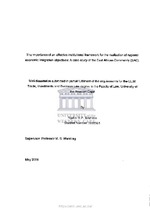| dc.contributor.advisor | Wandrag, M. S. | |
| dc.contributor.author | Ibrahimu, Ngabo M.P. | |
| dc.date.accessioned | 2021-02-09T11:22:41Z | |
| dc.date.available | 2021-02-09T11:22:41Z | |
| dc.date.issued | 2009 | |
| dc.identifier.uri | http://hdl.handle.net/11394/7789 | |
| dc.description | Magister Legum - LLM | en_US |
| dc.description.abstract | The East African Commu1nity (EAC) was re-established on 30 November
1999 by the Republics of Kenya and Uganda and the United Republic of
Tanzania1 signing the Treaty for the Establishment of the East African
Community (the Treaty). The Treaty came into force on 7 July 2000.2 The
Republics of Burundi and Rwanda acceded to the Treaty on 18 June 2007
and became full members of the EAC with effect from 1 July 2007.3 The EAC
was formed with the major aim of widening and deepening co-operation
among the Partner States in political, economic, social and cultural fields4
that would lead to equitable economic development in the region. | en_US |
| dc.language.iso | en | en_US |
| dc.publisher | University of the Western Cape | en_US |
| dc.subject | Council of ministers | en_US |
| dc.subject | Customs union | en_US |
| dc.subject | East African community | en_US |
| dc.subject | European community | en_US |
| dc.subject | Regional economic integration | en_US |
| dc.title | The importance of an effective institutional framework for the realisation of regional economic integration objectives: A case study of the East African Community (EAC). | en_US |
| dc.rights.holder | University of the Western Cape | en_US |

